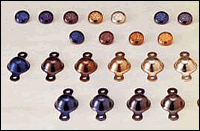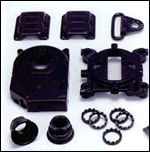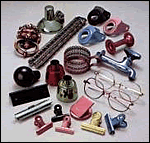HOME > Surface Finishing Tutorial > #308 Coloring and Plating
Surface Finishing Tutorial
#308 Coloring and Plating
Category : Electroplating
September 8, 2017
Each plating film has a color specific to the metal or the alloy that is based on. To produce more variations of colors, metal coloring or paint application can be adopted.
(1) Chemical conversion treatment and plating
| Vivid blue or red colors can be added to galvanized products directly by immersing them into a special coloring solution. One of the established methods of enhancing the metal feel of nickel or silver plating is to immerse the metal substrate into a special sulfide solution until chemical coating films are formed over it. Unique color tones can be also produced as the time of immersion increases. The color changes from pale gold -> gold -> red gold -> wine color -> blue purple -> navy blue. The scope of application has been expanding, as it is easy to process, colors are easily controlled and free from irregularities. To improve the durability, clear coating is applied at the end of the coloring process. |
 |
(2) Paint application and plating
(1) Galvanizing and black electrodeposition coating
| For automotive parts and electronic device components requiring exceptional durability and black color tones, the black electrodeposition coating (film thickness is between 10 - 20 µm) is not sufficient to obtain the required durability. Therefore, the black cation electrodeposition coating must be applied after galvanizing. |  |
(2) Decorative electrodeposition coating
| Applying chromatic cation electrodeposition coating over achromatic plating films, such as nickel plating, will add colors to the plated goods. |  |
* What is "electrodeposition coating"?
DC electrolysis on a product that is immersed in an electrolysis tank containing aqueous paint dissolved in water will cause the ionized paint components to be deposited on the product surface, forming a paint film. When the paint component acts as a negative ion, it is referred to as the anion electrodeposition coating. When it acts as a positive ion, it is called the cation electrodeposition coating. Using the cation electrodeposition makes the product serve as a cathode and does not cause plating films to be dissolved.
DC electrolysis on a product that is immersed in an electrolysis tank containing aqueous paint dissolved in water will cause the ionized paint components to be deposited on the product surface, forming a paint film. When the paint component acts as a negative ion, it is referred to as the anion electrodeposition coating. When it acts as a positive ion, it is called the cation electrodeposition coating. Using the cation electrodeposition makes the product serve as a cathode and does not cause plating films to be dissolved.
- Environmental conservation
- Hot Dipping
- Anodic Oxidation Process
- Anodic oxidation treatment
- Anodizing
- Corrosion - Corrosion Protection
- Electroless Plating
- Electroplating
- Heat treating
- Hydrogen embrittlement
- Metal cleaning
- Metal etching
- Painting
- Special paints
- Surface Treatment
- Surface-treated steel sheets
- Thermal Spraying



